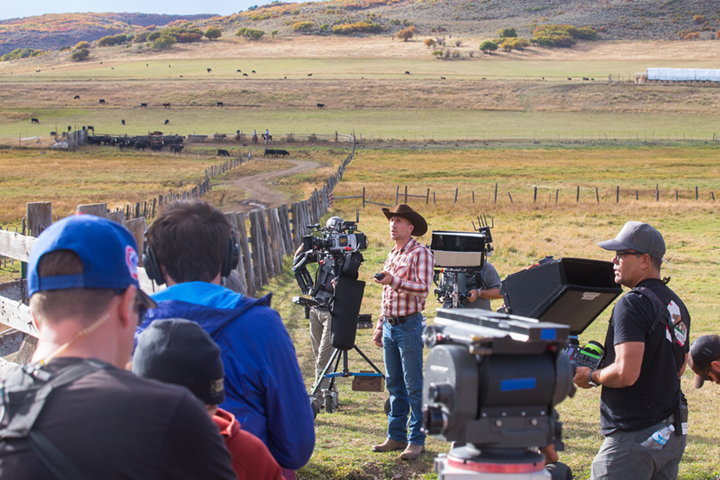
To be a top commercial director, you must learn to create and pitch fresh ideas to clients, earn your talents’ trust, and handle complex pre-production logistics.
As I’ve learned over the years, directing is so much more than what you might see on set, of just directing talent and camera movements.
In this post, I’ve listed some of the tricks I’ve learned as a commercial director, including:
• Prepping for a creative call with an ad agency or client
• Drafting an engaging commercial storyboard
• Efficient pre-production scouting techniques
• Avoiding decision fatigue during a shoot
• Using a campaign theme-word to guide your vision
• Getting your talent to trust your vision and coaching
• Bringing the action to life using dynamic camera angles
I wanted to share some lesser-known tips that you won’t necessarily learn at film school or by watching YouTube tutorials—however these are tips that are every bit as important to your success as any others.
1. Research the Brand Before the Creative Call
The creative call is your first chance to impress the client or the ad agency that represents them. And, since you’re usually competing against two other directors for the bid, you have to nail it.
Prior to the call, research the brand, the client, and the agency.
Knowing who your client competes against is key—it will help you understand how they’re positioning themselves against their competitors. You also need to understand the client’s brand, plus memorize examples of how they expressed it in their previous campaigns.
If the call is with the ad agency, you should know the projects they’ve worked on for the client and the other commercial director or directors they have worked with.
Next, take a look at the client’s past video projects. Note the equipment they used and the budget they likely spent—those aspects will give you a sense of whether you’ll likely be shooting on a DSLR run-and-gun style, or if you’ll have a budget for cinema-style cameras, full grip and gaffer teams, etc.
When you’ve finished your research, write down your talking points and the questions you’ll ask. (Logistics and budget questions are imperative!)
2. Drafting Storyboards
If you win the bid, it’s time to start working with an illustrator to create storyboards.
Storyboards help give a sense of place and flow to the campaign. I like to use generic illustrations so that the client won’t get hung up on small details—“I hate that person’s shirt”—which can happen if you use sample photographs on your board.
When I drafted a storyboard for a Cabela’s 2015 holiday commercial, I used 18 chronological illustrations—much like a comic book—that depicted the story of a man driving through a snowstorm to give his grandson Christmas presents. I kept the storyboard black-and-white so that the client could picture the scenes however they liked.
Just remember that if you’re presenting your storyboard to an agency, they’ll offer feedback—as a commercial director, you should always incorporate their notes and perfect the storyboard before you resubmit.
3. Meticulous Pre-Production
The old aphorism “an ounce of prevention is worth a pound of cure” applies perfectly to planning a shoot.
It’s crucial to meticulously plan your shot timing, lens choice, and company move-time between scenes, long before you begin filming. As the director, you are responsible for all of this. For example, I filmed professional hunters Jim and Eva Shockey elk hunting on a remote Colorado mountaintop for a 2016 Cabela’s brand anthem. To pull it off, we needed snowmobiles and snow cats—plus a few horses for the sunrise scene.
It would have been impossible to shoot that commercial on-the-fly—there were tons of moving parts and little traps that could have pushed our crew into overtime.
So, my producer (Danny Taff) and I created a meticulous shot-timing document prior to the tech scout, which we shared with the key crew. After hearing their feedback, we locked down the schedule.
Squeeze every ounce from your budget. Is it necessary to have all key crew on hand during the tech scout? If not, cut some positions for that day. It’ll save you money, which you can spend on extra crew or camera tools on shoot day.
4. The Commercial Director’s Scout — Your Time to Wrap Your Head Around the Scenes
The director’s scout is crucial for figuring out:
1. Your shot timing
2. When and where to be for the best light and most efficient use of crew time
3. Company moves and timing
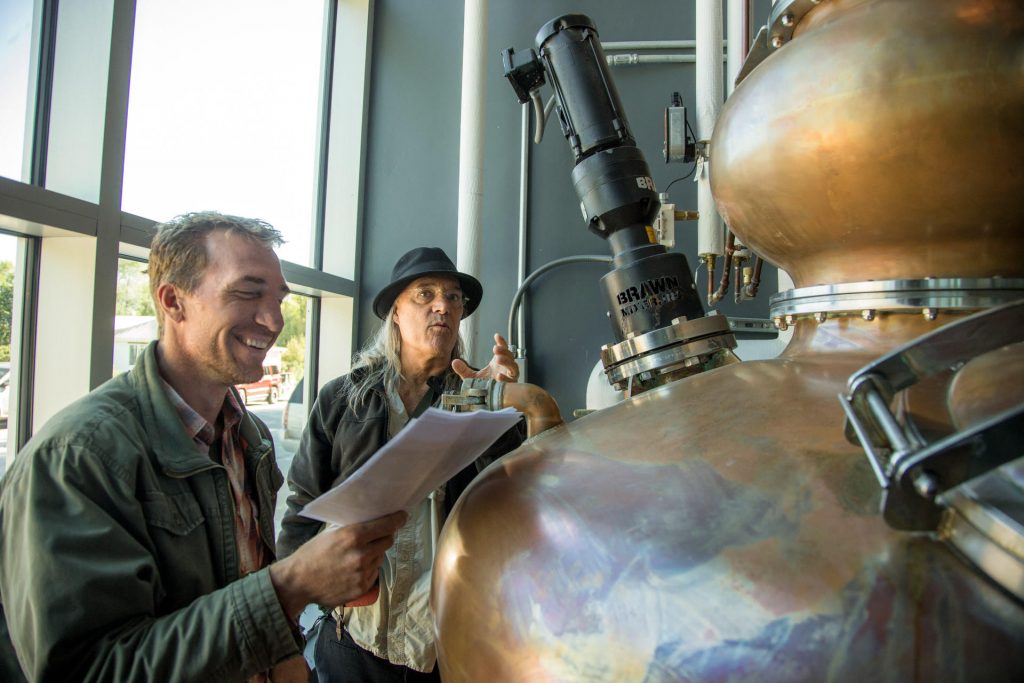
Scouting with Russell Carpenter for the Canon C700 short film “The Calling.”
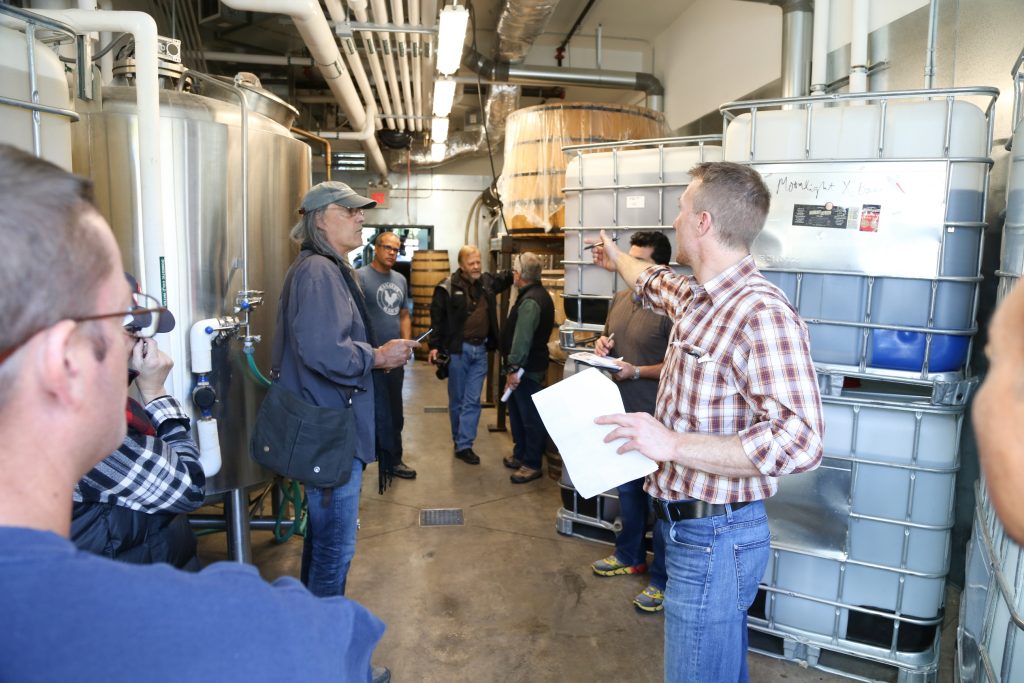
Making sure the entire crew is dialed before shooting “The Calling.”
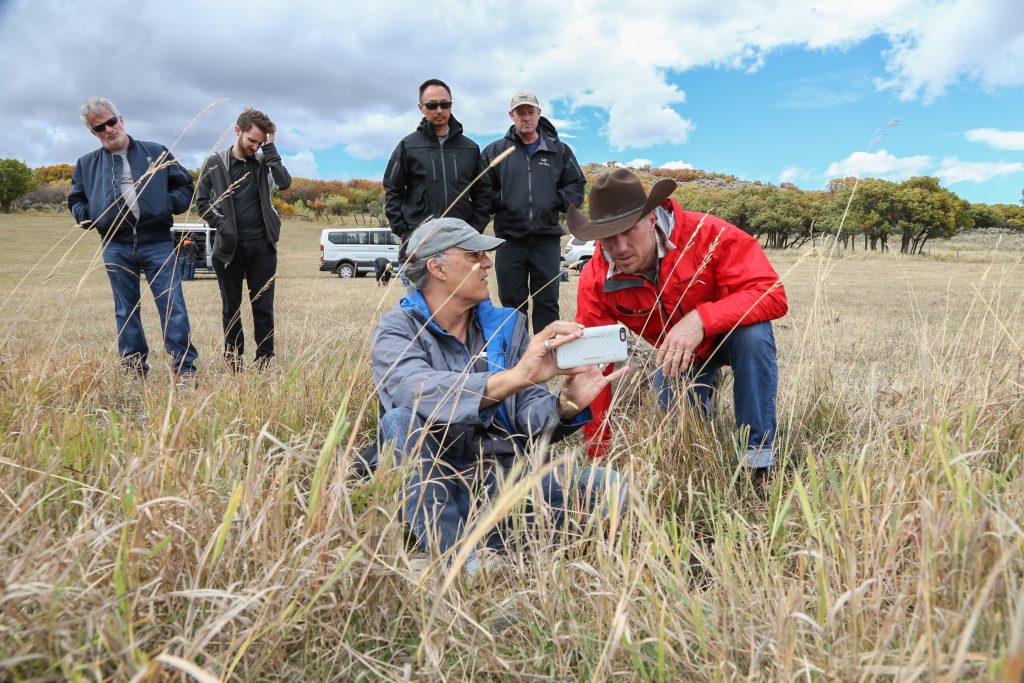
Using the Sun Seeker App to calculate the perfect shot.
Take LOTS of time to walk the locations. On your walks, envision the camera in specific positions and begin mentally positioning the talent. Use the Sun Seeker iPhone app to gauge exactly where the sun will rise and set from your positions.
If you need to take unpaid days to lock these details down, do it.
I had a limited scouting budget when I directed Cinch Jean’s “Out Here” cowboy and ranching commercial, so I drove to the ranch several times in the weeks before the shoot. (Luckily, the location was only 30 minutes from my house.)
There were multiple barns on the property and miles of fence-line—if I’d restricted my scouting time to only the allotted budget, I wouldn’t have found the perfect filming locations. So, I scouted the entire ranch, scoping out every section of fence-line and all angles of every barn.
I worked a lot of unpaid hours, but the commercial won a national Telly Award, and the client loved it. Now, it’s a key part of my director’s reel. Totally worth it.
The point is, never settle for “good enough.” Directing is such a competitive industry, that raising the bar on your scenes by, say, just five percent will noticeably improve the quality of your work.
5. The Tech Scout — Planning with Your Key Crew
During the tech scout, talk with your DP about which cameras to use and which lenses you’ll need for each scene. (If you’re the DP, do this yourself.) Coordinate with your producer about which art effects and props you want for each scene, and make sure to let him or her know exactly what time each prop is needed on set. Finally, discuss your lighting needs with your gaffer and key grip—figure out how much time they’ll need to set up and what backup gear they might want in case of bad weather, etc.
When we filmed country music star Luke Bryan for a Cabela’s fly-fishing commercial in Wyoming, we had to get the footage, plus record his voice-over, in less than eight hours.
Adding to the challenge, we were shooting in a river, far from any power source—the generator for our lights, and all grip equipment, had to be hand-carried to the location. The day before filming, we did a tech scout and made a detailed plan for shuttling every item of gear across the river and up the far bank a quarter mile.
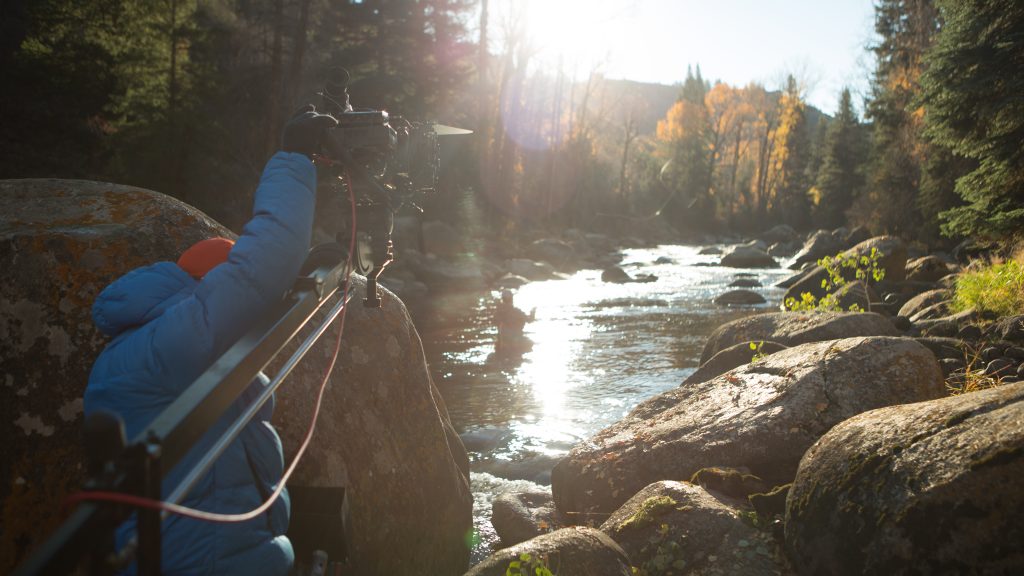
Filming at sunrise on the Roaring Fork River in Aspen for a Cabela’s “It’s In Your Nature” brand anthem. The crew had to hand-carry everything to the location, adding to the prep time. Scouting was crucial for this shot.
I asked the DP, the gaffer, the key grip and the producer how much time they would need to move their team’s equipment to each location. From there, we made a time schedule so we could film Luke fishing at the perfect sunset moments.
One other tip: It’s crucial to be dialed with your shot timing and transition time when filming a celebrity—his or her time is often much more expensive than your crew’s.
6. Research and Seek Inspiration Online
The web is your friend and as a commercial director, you have to bring the inspiration and energy.
Get inspiration from brands completely out of your client’s field and adapt them to your project. Take screenshots of creative camera angles, lighting setups, talent expressions, and anything else that speak to you. Share those with your creative director and see how he or she resonates with your ideas—it’ll help each of you understand the other person’s vision.
Remember: Take the time to see what you client’s competitors are doing, too.
7. Hire the Best Line Producer You Can Afford
A line producer handles the lion’s share of the day-to-day production responsibilities, and his or her attitude and resourcefulness will make or break your project.
I like working with producers who are resourceful, stay calm under pressure, and know a lot of potential backup personnel, in case a crew member gets sick, or the client wants to change locations at the last minute.
Great producers will keep you informed about production details without weighing you down with minutiae details.
8. Avoid Decision Fatigue
“Decision fatigue” isn’t something you can fight with coffee. Towards the end of long day of shooting, it can cripple your creative thinking as a commercial director. In the pre-production stages, decision fatigue can smother your ability to craft artful storyboards or to understand the big picture.
Working at the top of your game involves making hundreds—even thousands—of decisions each day: figuring out camera-angle changes and aperture settings, deciding how to motivate a grumpy 4-year-old actor who’s already had too much sugar, noticing fly-away hair strands on talent, etc. All those details are important, but each choice takes a toll on your ability to see the big picture and make important creative decisions.
This article by writer and photographer James Clear talks about the costs of decision fatigue, plus how to avoid it, and is a great read for anyone wanting to become a commercial director.
To prevent decision fatigue, optimize each day’s schedule toward boosting your creative output, instead of dealing with low-priority tasks.
Here’s an example: It’s mid-morning on a shoot day, and you’ve been filming for a couple of hours. During a break, a production assistant comes around with a lunch menu from a local deli. There are 15 sandwich options, five salads, and an assortment of sides and drinks. How do you choose lunch?
You don’t choose. In my case, I don’t look at the menu. I say, “Thank you very much; I don’t care, please order me a salad and a sandwich, whatever looks good.” That’s a simple prioritization: keeping your mind clear to focus on the day’s immense creative challenges is far more important than the flavor of your sandwich.
Fighting decision fatigue is a longer process than what we can discuss here — but if the topic interests you, I highly suggest you research the subject. It’s crucial to the role of a commercial director and to staying creative and mentally sharp during both pre-production and shoot days.
9. Connect to Your Subjects
Agencies and clients look for a commercial director who can create emotionally connective campaigns. For me, this means creating a heartfelt bond to the talent and location—a bond that shines through in the cinematography and grabs the viewer.
I use a couple of key operating principles to achieve this.
1. Use relatively wide-angle lenses and move in close to your subjects. I like to work with a 24mm or 35mm lens when filming on a super 35mm sensor, or a 35mm or 50mm lens when using a full-frame sensor.
This minimizes the ‘atmosphere’ between the camera and subject, which brings the viewer in close. Here, you can feel the talent’s breath, and see nuances in their eyes as they act.
2. If you don’t establish a heartfelt connection with the talent, they won’t trust you when you coach them. Even the world’s best athletes and actors rely on coaches and feedback every day in their careers — and your day on set as a director is no different.
To connect with the talent, meet with them off set before they walk in front of the cameras—maybe in the motorhome or dressing room. Show them the storyboards, tell them what the campaign is trying to achieve, and share the general themes of the shoot. Explain clearly what type of performance you’re looking for from, and also what’s not needed.
The stronger the trust and bond you establish with your talent prior to being on set, the better their performances—and the overall product—will be.
When I shot Cinch Jean’s “Out Here” TV commercial, the subject was a real-world ranching family during spring calving season. We shot on their ranch in Old Snowmass, Colorado, and at first, it wasn’t easy to make them feel comfortable—especially the daughters, who were middle school-aged.
So, I took the time to chat with them during the scouting process and before they came on set; I brought my daughter along for one of the scout days as well so we could share family stories. This helped establish a sense of mutual trust, and it was much easier to get soulful, authentic shots. I also took care to engage them in the creative process so that they felt like a part of the crew.
Remember: it’s tough to capture someone’s essence, background, and lifestyle, during only a few short hours of shooting—especially when they haven’t been filmed before.
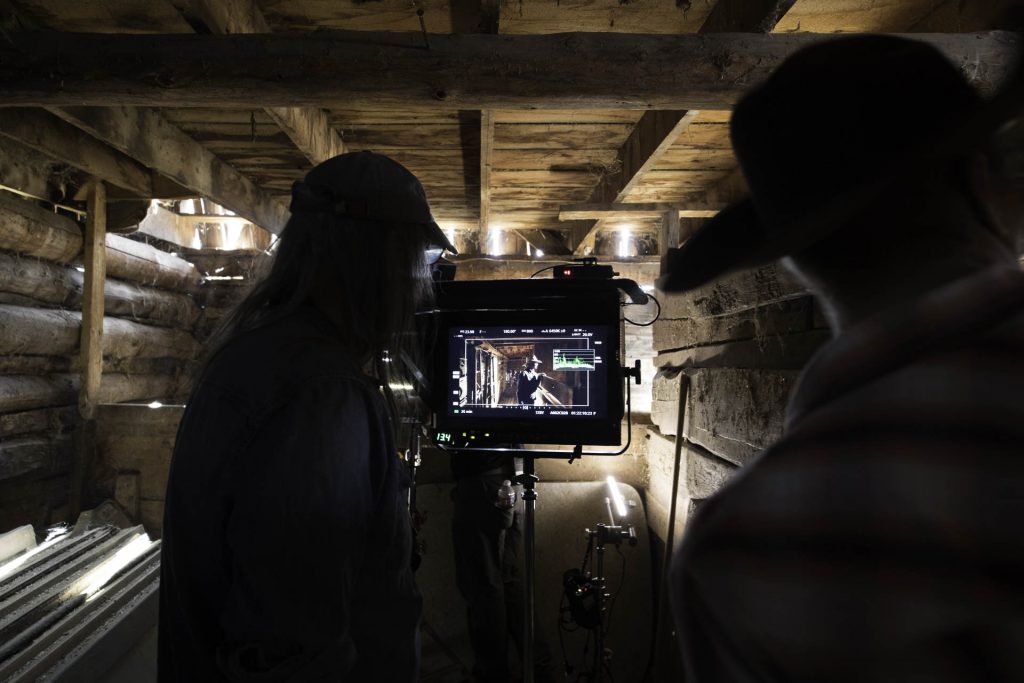
Filming, only after earning the trust of the subjects.
10. Create and Capture the Action
Capturing dynamic scenes is all about moving the camera and talent in creative ways. It can be tougher than it sounds as a commercial director.
When doing video work, you’ll sometimes work with talent who have never been in front of a professional camera, such as athletes. Don’t be afraid to give them direction. Your job as the director is to encourage them to be lively and animated, while also ensuring their performances are not over-the-top.
As for capturing dynamic scenes through camera movement, remember that you can’t be everywhere at once—motivate your crew to move the camera in mindful and creative ways, and give them feedback on what’s working and what isn’t. Experimenting with various camera angles—tight close-ups, extreme low-angle shots, and wide-angle shots from a distance—will produce a much livelier product than if you shoot every scene using the same technique.
Here’s an example.
When my team shot “The Calling”, a Canon short film about life in Colorado’s high country, we used a wide range of camera movements, including: Steadicam, ATV cam, crane, dolly, and shoulder mount in various situations, as well as locked-off tripod shots. This created a fluid mix of dynamic camera moves throughout the video, plus it reflected the professionalism and craft of our subjects—a pair of rock climbers, a rancher, and a spirits distiller.
In the distillery scenes, we used a dolly for smooth slider moves, but also shoulder-mount vantages right up close to the distiller. The latter gave a feel of authenticity to the cinematography.
On the ranch, we used a Steadicam on an ATV to stabilize the horseback footage. We also used the Steadicam to add camera motion to the cattle-drive scenes, and included shots with the camera drifting along the fence line.
With the rock climbing scenes, our grip team led by Matt Stelling constructed a crane on a steep hillside to capture sweeping footage of the climber ascending, but we also used ultra-wide angle lenses, hand-held below the climber’s feet and pointing straight up into the sun, which added an authentic hand-held feel to the footage.
11. Develop a Theme Word for Your Campaign
Your campaign should have a clear goal—and I find that selecting a perfect theme word acts as your North Star. I’m always amazed how it can guide my decision-making process as a commercial director.
My team has filmed national TV campaigns for Cabela’s, composed of multiple fishing, camping, and hunting commercials, and our campaign goal was clear: brand Cabela’s as the country’s top outdoor outfitter so that they sold more fishing, camping and hunting equipment.
But the theme word my team and I developed for a few of the campaigns was “connection” —not “fishing,” “camping,” or “hunting.”
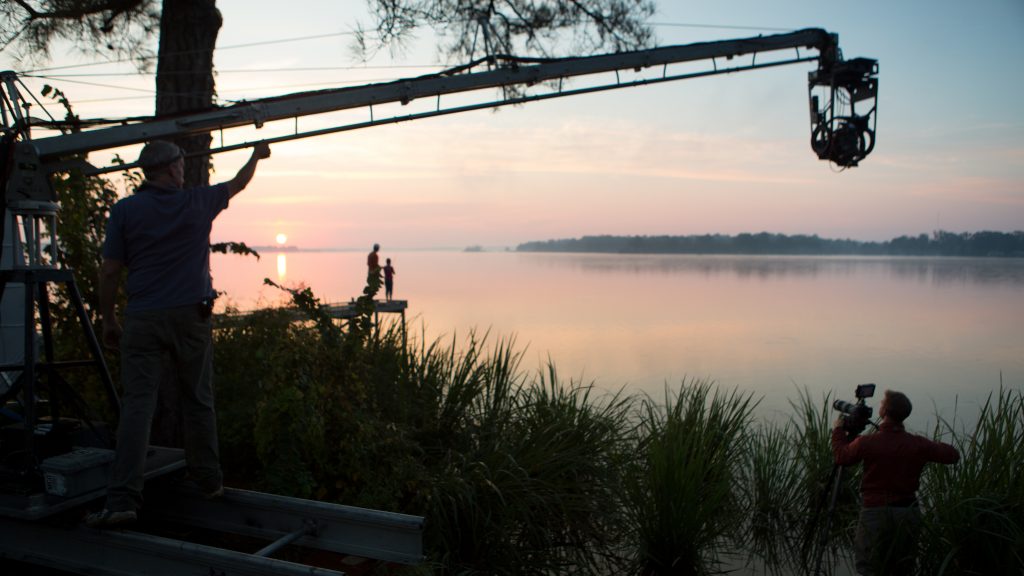
Behind the scenes of the Cabela’s Disconnect Day commercial as part of the “It’s In Your Nature” campaign.
“Connection” embodied the powerful beauty of the outdoor landscapes. It described what the families we were filming felt when they were in the wilderness, phones off. It even summed up each person’s association to his or her true self, which was enhanced by being alone in nature.
Connection was the theme word I used when my team shot Cabela’s 2016 commercial “Disconnect Day.”
Consider each of your scene-decisions against your theme word, and ask yourself: “Is this decision moving me closer to the essence of my theme word, or is it taking me farther away?” This will help when you’re writing storyboards, on the director’s scout, and planning each scene’s location. It even helps during little decisions, like whether to use a 35mm lens or 50mm lens for a scene.
In conclusion, those are my top tips you may not have learned in film school. Becoming a commercial director is not easy and it is a very long road but is one of the most rewarding forms of expression in the creative world.